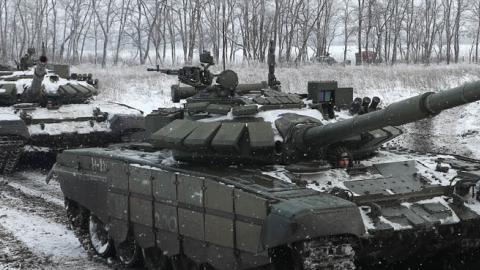America may be back, but its geopolitical antagonists are not putting out the welcome mat. During the last year, Chinese warplanes regularly darkened the skies over Taiwan, North Korea restarted ballistic and hypersonic missile testing, and Iran intensified drone attacks around the Middle East. The approach of “ integrated deterrence ” planned by Pentagon officials for their upcoming defense strategy does not seem to be resonating with its target audience.
Although provocations from Beijing, Tehran, and Pyongyang cannot be ignored, the most immediate challenge facing U.S. leaders is the Russian army poised at Ukraine’s doorstep and threatening invasion. The Biden administration’s promised economic sanctions and military equipment are making little obvious impact, and NATO allies are reluctant to support more aggressive responses like isolating Russia from the global financial system that could lead Moscow to cut off Europe’s natural gas in the dead of winter.
Instead of wringing their hands at Russia’s aggression, the DoD’s policy shop should learn from Vladimir Putin’s example. By mobilizing threats in multiple domains, ranging from mercenary incursions and cyber attacks to armored ground combat, the Russian government built an array of options that U.S. and allied leaders are hard-pressed to counter. And Moscow’s levers extend well beyond Ukraine’s borders, thanks to decades of undersea reconnaissance that could already be disrupting transatlantic communications and a longstanding space program that just last month destroyed a defunct Russian satellite.
The Putin regime’s effort to bring Ukraine back into Russia’s fold is an excellent case study in what we call “ decision-centric warfare. ” By generating more options for Russian aggression compared to those available to Ukraine and its supporters, the Kremlin is imposing a series of dilemmas on its opponents. For example, If Western military support makes an incursion into the Donbass more fraught, Russia can pursue a decapitating attack on Kyiv with its Belarussian ally. If U.S. and European governments cut Russia off from the global financial system in the wake of an invasion in Ukraine’ east or south, Moscow can throttle undersea communications that carry trillions in Western transactions per day. Or if U.S. and allied negotiators attempt protracted negotiations to deny Russia a pretext for war, Moscow can empower its paramilitaries and proxies to resume their gray-zone offensive.
In contrast to approaches like those used by U.S. forces in Iraq that rely primarily on destroying or neutralizing enemy forces to win, decision-centric warfare attempts to create a larger and more diverse set of options than is available to the enemy. The asymmetry in choices causes the opponent to dilute its efforts across multiple courses of action or attempt to predict which path the decision-centric force will pursue. When the decision-centric force acts, it can choose among the options most likely to succeed while retaining the ability to shift options after the opponent commits to a response.
Generating options requires persistent engagement
The optionality advantage enjoyed by Russia regarding Ukraine is neither unique to Russia nor unachievable by U.S. and European governments. Arguably the West has similar or better military capabilities and a superior array of economic and diplomatic tools than the Putin regime. The difference is the Kremlin shows a willingness to employ all the tools at its disposal.
Based on their behavior, Russia and China have decided the risk of demonstrating their resolve and capability is worth the benefit. Against smaller countries, the threat of military or economic attack can be enough to coerce or compel. Against major powers that can fight back, options need to be credible and able to evolve. Over the past decade, China built its option set through island-building in the South China Sea, harassing military and commercial shipping with its maritime militia, and economic warfare against its opponents. Russia did the same with its “little green men” in Eastern Europe, control of westward gas flows, and internet-enabled political warfare.
One part of the U.S. military regularly demonstrates and refines options like China and Russia, but the approach is not widely employed across the force. Under its strategy of “ persistent engagement, ” U.S. Cyber Command’s operators retaliate against adversary computer network attacks in real-time and mount exploitation and offensive actions of their own to demonstrate U.S. resolve and capability. And the interaction between U.S. and adversary operators enables Cyber Command to improve its future courses of action.
As Pentagon leaders put the finishing touches on their new defense strategy and implement the Joint Warfighting Concept, they should take a page from the Russian and Chinese playbooks. Integrated deterrence is likely to fail unless it provides U.S. and allied leaders a superior range of credible options that pose dilemmas for opponents, which will require persistent engagement and demonstrations of capability and resolve. This approach involves risk, but that is the price of admission for great power competition.
Read in Defense One

















